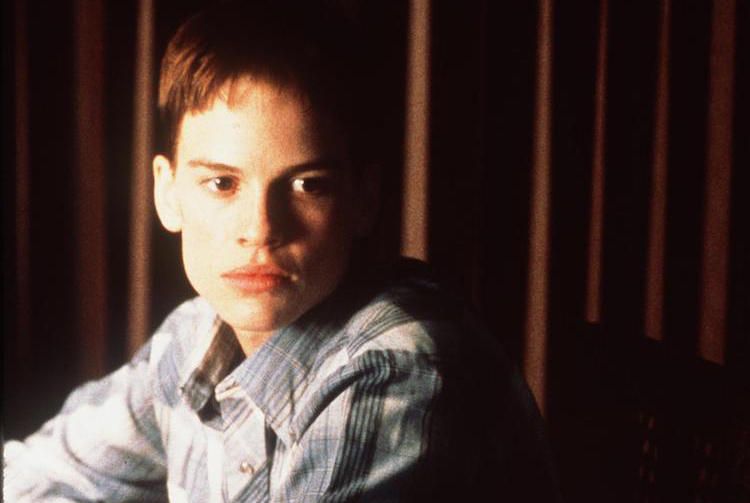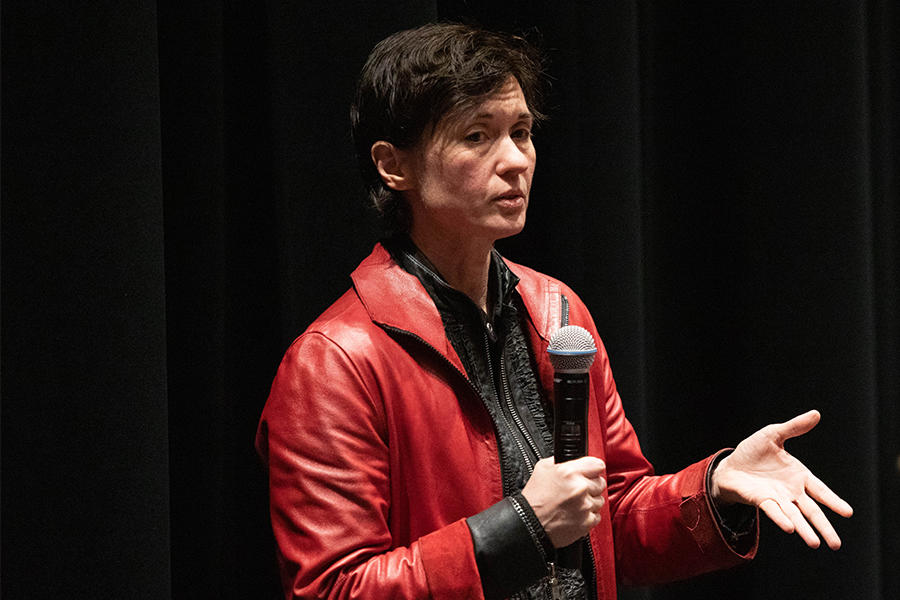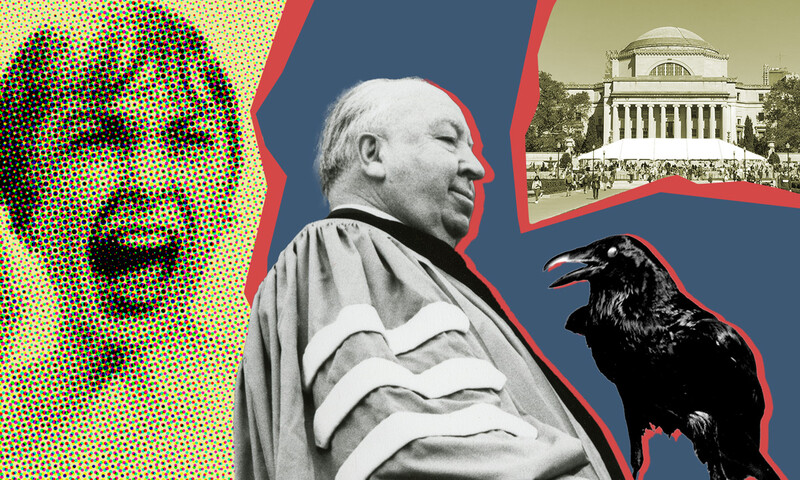In the fall of 1993, Brandon Teena, a young, mercurial, charismatic drifter, traveled a hundred miles from his home in Lincoln, Nebraska, to the small town of Falls City, where he wooed seventeen-year-old beauty Lana Tisdel. An ardent romantic, the twenty-year-old showered his girlfriend with gifts bought with forged checks and gained the trust of Lana’s hard-drinking, hell-raising friends. But when two of those friends, ex-convicts Thomas Nissen and John Lotter, learned that Brandon was transgender, they raped him and, days later, shot and stabbed him to death.
The story of Brandon’s last days was told in the 1999 movie Boys Don’t Cry, cowritten and directed by Kimberly Peirce ’96SOA. The film challenged sensibilities and pushed viewers into new moral territory, while achieving an artistic unity rarely seen in a debut. And as awareness of trans life continues to evolve, Boys has also been the subject of lively debates about terminology and portrayal. Over the past year, to mark the twentieth anniversary of the film’s release, Peirce has been speaking at screenings around the country. One was at Columbia’s Lenfest Center, where the audience included School of the Arts film students who had taken a master class with the director earlier that day. A panel discussion was scheduled for after the screening, but before the film even began Peirce walked onstage and asked the audience to try to imagine what it must have been like, twenty-seven years ago, to be Brandon Teena.
Try, Peirce said, to imagine the power of Brandon’s desire to be himself in a place where there was nothing, and no one, to support him. Rural Nebraska was not New York City or San Francisco. Google did not exist. There was no social media, no concept of sexual fluidity or a continuum, and, in most cases, no tolerance for anyone living outside the binary paradigm as it was then understood. Much of America could not accommodate the idea of Brandon Teena, and yet he went out into the world and attempted to live authentically.
Said Peirce, “I wanted to capture the power of his desire to shape himself into who he was, because that was extraordinary.”
At the time of Brandon’s death, Peirce was studying film at Columbia and living in the East Village. But even there, in a mecca of sexual broad-mindedness — a million psychic miles from Falls City, Nebraska — Peirce was struggling to figure out her own sexuality. “I remember bicycling past the Lesbian and Gay Film Festival and thinking, ‘Maybe I’m gay, but I don’t know how to be gay and won’t be good at it,’” she told the audience. “I was flush with my identity coming to the fore, and I knew I wanted to tell a story about someone who lived as a man.”
But her ideas weren’t panning out, and Peirce was frustrated — and anxious. Then one April night in 1994, a colleague at the Midtown law firm where Peirce worked part-time brought in the latest issue of the Village Voice. There, on page 24, was an article by Donna Minkowitz called “Love Hurts,” with the subtitle: “Brandon Teena was a woman who lived and loved as a man. She was killed for carrying it off.” Riveted, Peirce read the long article straight through, aware of a strange yet unmistakable flame kindling inside her. “I felt like I had been baptized in fire,” Peirce said. “I was in love. It was the strangest thing: I just was obsessed. I needed to figure out who Brandon was and how he lived.”
Peirce started her thesis project, a short film based on Brandon’s life, but her money ran out and the footage ended up trapped at DuArt, a postproduction facility in Manhattan. Then producer Christine Vachon — the soon-to-be founder of Killer Films and the hottest name on the New York indie scene — heard about Peirce’s project and invited her to a meeting. It was an opportunity any film student would die for, but Peirce had nothing to show. She asked Vachon if she would spring the dailies from DuArt. Vachon did, and after watching them, she declared that the story ought to be a feature. And so while Vachon sought financing, Peirce immersed herself in the world of Brandon Teena.
She started by traveling to Nebraska with an activist group called the Transexual Menace to attend the murder trials of Nissen and Lotter. She read court transcripts, interviewed Lana Tisdel, and learned all she could about Brandon’s early years growing up in a trailer park. And she spent three years on the hardest task of all: finding someone to play Brandon.
Back then she wasn’t even sure how to define Brandon. Was Brandon a transgender man or a butch lesbian? Even the terminology was in flux, always a few steps behind the lived realities of those who did not neatly fit into established categories. “We really thought we would find either a trans person or a butch,” Peirce said. “We brought in all the hot drag kings.” Some of the people she auditioned identified as butch lesbians but now identify as trans men. “You didn’t get any straight people, because at that point playing gay was a dangerous thing to do.” Then, in April 1997, comedian Ellen DeGeneres came out as gay, a cultural turning point that Peirce saw reflected in her auditions. “That’s when we had cisgender straight women coming in, and they wanted to play the part. It was interesting, because they’d come in with a sock in their pants and hair pulled back and be like, ‘Hi.’” It was clear to Peirce that they couldn’t pull off masculinity in the internalized way she wanted. “The movie needed the person to pass as a man” to the other actors, Peirce said. “If they didn’t pass, there was no authenticity.”
Meanwhile, Vachon found two producers who would finance the movie, and casting director Kerry Barden assembled a stellar ensemble, with Chloë Sevigny as Lana, and Brendon Sexton and Peter Sarsgaard as Nissen and Lotter.
With four weeks to go before shooting, Peirce was in a panic. Barden had looked at hundreds of actors to play Brandon, and “each one was worse than the last,” Peirce recalled. Then one day, during Barden’s lunch hour, a young woman in a cowboy hat walked in. It happened that she hailed from Lincoln, Nebraska, Brandon’s hometown. Barden knew her — she had auditioned for Whit Stillman’s The Last Days of Disco, which Barden had cast, but she didn’t get the part. After her audition for Boys Don’t Cry, Barden FedExed the tape to Peirce. Two nights later, Peirce and producer Eva Kolodner were in the Killer Films office at 380 Lafayette and put the tape in the VCR. It was 10:00 p.m., and they were exhausted. They watched as the millionth would-be Brandon walked on. Peirce got a chill and hit pause. Oh my God, she thought. That’s him.
“A human being was on that screen,” Peirce explained. “We had never seen everything all at once. That human being had a jawline that was androgynous, had the ears and the forehead, had a kind of swagger and sex appeal, and smiled. That was what hit me — that person charmed the screen. We brought that person in, and that person performed, and it was just clear that the person we’d been dreaming about was there. And it was a miracle.”
Hilary Swank, a relative unknown, would win the 2000 Academy Award for best actress for her performance as Brandon Teena in an Oscar field that included Meryl Streep, Annette Bening, and Julianne Moore. In her acceptance speech, Swank thanked Peirce for her “fierce tenacity and vision” and ended with a tribute to Brandon: “His legacy lives on through our movie,” Swank said, using a pronoun heard round the world, “to remind us to always be ourselves, to follow our hearts, to not conform.”
After the Lenfest screening, Peirce was joined on stage by members of her creative team, including actors Sexton and Sevigny; cinematographer Jim Denault, who had shot a bunch of Columbia student films and first met Peirce through that network; and Andy Bienen ’96SOA, associate professor of film at Columbia and cowriter of Boys Don’t Cry.
Peirce’s student film was fictionalized, and during the panel it was revealed that, for the feature, the producers convinced Peirce to use real names, embrace the true story, and then take whatever narrative license she needed to make the film better. For Peirce, this was the key breakthrough. “It was a bold move to go real,” she said.
Sevigny certainly went real with Lana, the character whom Peirce said is the “way in” to the movie for many viewers. The actress spent a lot of time meditating on images of Lana and Brandon, enthralled by their attractiveness and their outlaw vibe. “I remember looking at these photos and being so obsessed with Brandon’s swag and how he owned it. I was in love with them and their love story.”
“When I first met Lana, we had thought that part of the key to the script was: when did she know that Brandon was a female-bodied person?” said Peirce. “Back then you used the term ‘girl.’ I said, ‘When did you know Brandon was a girl?’ And she said, ‘Oh, I always knew Brandon was a girl.’ And I thought, Oh, God, we don’t have a movie. I said, ‘So you always knew Brandon was a girl?’ And she said, ‘No, I didn’t know until we stripped.’” Peirce realized that Lana was an unreliable narrator who had a shifting understanding of Brandon that bounced around under the influence of her own feelings and society’s need to define him. This called for subtlety in the screenplay: it was important for Peirce that the viewer be inside Lana’s desire for Brandon the human being, even as she was “going in and out of acknowledging or knowing” that Brandon was trans, and “weighing how important that was to her.”
One of the film’s most indelible scenes is the rape of Brandon by Nissen and Lotter. After the first take, Sexton went off by himself and lost it. “I just cried for forty-five minutes,” Sexton recalled, still visibly shaken from having just watched the film for the first time in twenty years. For Peirce, who has been candid about her own history of being physically and sexually abused, the decision to film the rape was fraught, but she felt she had insight into it and was committed to representing it in a way that “wasn’t pornographic,” she said.
The film honors Brandon and has been honored in kind. Last year, Boys Don’t Cry was inducted into the Library of Congress’s National Film Registry. Peirce went on to direct Stop-Loss (2008), about young soldiers returning from the Iraq War, and Carrie (2013), a remake of the horror classic, and has recently directed episodes of the Netflix show Dear White People and Showtime’s Kidding, starring Jim Carrey.
Twenty years after the release of Boys Don’t Cry, Peirce is still amazed that the film happened, and she never imagined it would be so passionately embraced. “I was a kid,” she said. “I’d been through one year of film school. I didn’t know anything. I hadn’t made a movie. I said to myself, ‘I have to be a good writer and director to serve the movie. I have to do this right.” Today she still refers to what a “miracle” it was that she got the film made and invests that mission with an almost religious ardor.
“Boys,” she said, “was just the greatest calling in the world.”




